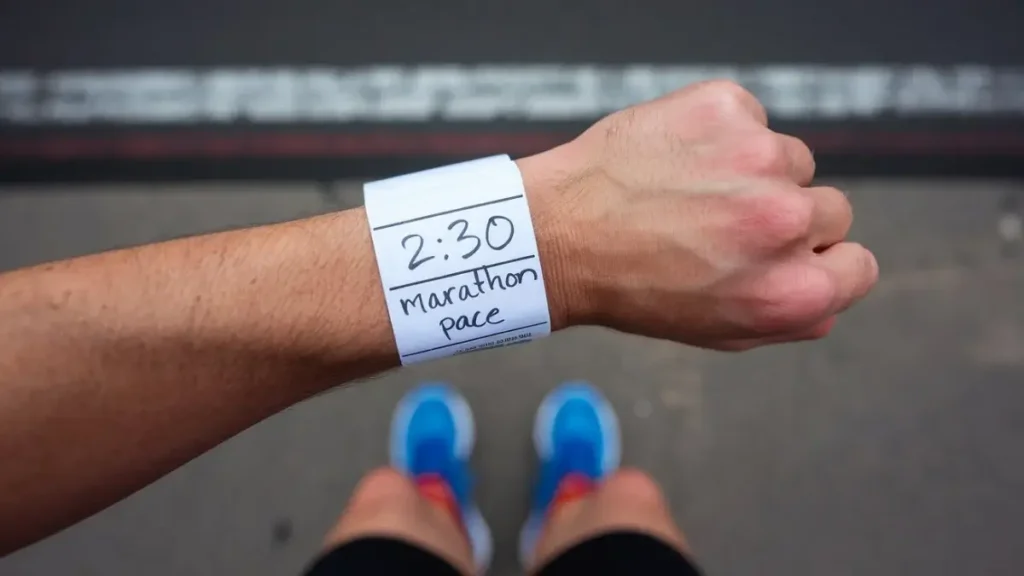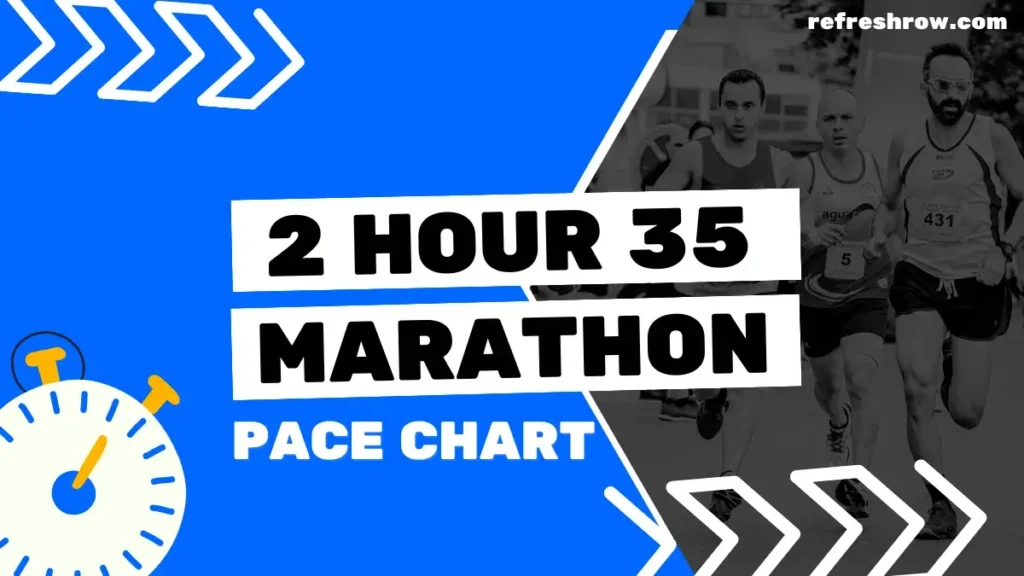To run a 3:55 hour marathon you need to run at a pace of 8:58 per mile or 5:34 per kilometer.
Following the splits below (and shaving off a second), you’ll run a sub 3:55 marathon.
I’d recommend aiming to run 1-2 minutes ahead of the split target time from 10 miles, as you’ll likely come up against crowding on race day.
3:55 Marathon Pace in Miles
| Mile | Split |
|---|---|
| 1 | 8:58 |
| 2 | 17:56 |
| 3 | 26:53 |
| 4 | 35:51 |
| 5 | 44:49 |
| 6 | 53:47 |
| 7 | 1:02:44 |
| 8 | 1:11:42 |
| 9 | 1:20:40 |
| 10 | 1:29:38 |
| 11 | 1:38:36 |
| 12 | 1:47:33 |
| 13 | 1:56:31 |
| 14 | 2:05:29 |
| 15 | 2:14:27 |
| 16 | 2:23:25 |
| 17 | 2:32:22 |
| 18 | 2:41:20 |
| 19 | 2:50:18 |
| 20 | 2:59:16 |
| 21 | 3:08:13 |
| 22 | 3:17:11 |
| 23 | 3:26:09 |
| 24 | 3:35:07 |
| 25 | 3:44:05 |
| 26 | 3:53:02 |
| 26.2 | 3:55:00 |
Download
3:55 Marathon Pace in KM
| KM | Split |
|---|---|
| 1 | 5:34 |
| 2 | 11:08 |
| 3 | 16:42 |
| 4 | 22:17 |
| 5 | 27:51 |
| 6 | 33:25 |
| 7 | 38:59 |
| 8 | 44:33 |
| 9 | 50:07 |
| 10 | 55:42 |
| 11 | 1:01:16 |
| 12 | 1:06:50 |
| 13 | 1:12:24 |
| 14 | 1:17:58 |
| 15 | 1:23:32 |
| 16 | 1:29:07 |
| 17 | 1:34:41 |
| 18 | 1:40:15 |
| 19 | 1:45:49 |
| 20 | 1:51:23 |
| 21 | 1:56:57 |
| 22 | 2:02:32 |
| 23 | 2:08:06 |
| 24 | 2:13:40 |
| 25 | 2:19:14 |
| 26 | 2:24:48 |
| 27 | 2:30:22 |
| 28 | 2:35:57 |
| 29 | 2:41:31 |
| 30 | 2:47:05 |
| 31 | 2:52:39 |
| 32 | 2:58:13 |
| 33 | 3:03:47 |
| 34 | 3:09:22 |
| 35 | 3:14:56 |
| 36 | 3:20:30 |
| 37 | 3:26:04 |
| 38 | 3:31:38 |
| 39 | 3:37:12 |
| 40 | 3:42:47 |
| 41 | 3:48:21 |
| 42 | 3:53:55 |
| 42.2 | 3:55:00 |
Download
Other Marathon Pace Charts
Targeting a different time?
Check out the Full Marathon Pace Chart in Miles or KM
Or select a specific finishing time below:
| 3:00 | 4:00 | 5:00 | |
| 3:05 | 4:05 | 5:15 | |
| 3:10 | 4:10 | 5:30 | |
| 3:15 | 4:15 | 5:45 | |
| 3:20 | 4:20 | 6:00 | |
| 3:25 | 4:25 | 6:15 | |
| 2:30 | 3:30 | 4:30 | 6:30 |
| 2:35 | 3:35 | 4:35 | 6:45 |
| 2:40 | 3:40 | 4:40 | 7:00 |
| 2:45 | 3:45 | 4:45 | |
| 2:50 | 3:50 | 4:50 | |
| 2:55 | 3:55 | 4:55 |
Training for a 3:55 Marathon
Is 3:55 a Good Marathon Time?
Well, what do the stats say?
Run Repeat conducted a study that contains 19,614,975 marathon results from more than 32,335 races across the globe, here is how a 3:55 marathon compares against age and gender for the races recorded:
| Overall | You’re faster than 76.4% of all runners. |
| Male | You’re faster than 68.3% of males. |
| Female | You’re faster than 87.2% of females. |
| <20 | You’re faster than 72.8% of under 20s. |
| 20-29 | You’re faster than 71.0% of 20-29 year olds. |
| 30-39 | You’re faster than 71.1% of 30-39 year olds. |
| 40-49 | You’re faster than 75.2% of 40-49 year olds. |
| 50-59 | You’re faster than 84.2% of 50-59 year olds. |
| >60 | You’re faster than 96.0% of over 60s. |
Training Runs and Paces for a 3:55 Marathon
To break a 3:55 marathon you’ll need to do some serious distance in your training, I recommend at least 20 miles (32km) per week.
You’re also going to need to make sure you’ve crossed off these milestones for other race distances:
- A 5k in 24:30 mins
- A 10k in 50:50 mins
- A half marathon in 1 hour 45 mins
Training Paces
| Pace | Mins per Mile | Mins per KM |
|---|---|---|
| Easy | 10:06 | 6:16 |
| Steady | 8:58 | 5:34 |
| 10k | 8:13 | 5:06 |
| 5k | 7:53 | 4:54 |
| 1 Mile | 7:19 | 4:34 |
Weekly Mileage Targets
| Target Mileage: | Gradually increase your weekly mileage from 30 miles (48 km) to a peak of 50 miles (80 km). |
| Incremental Increase: | Increase mileage by approximately 10% each week, with every fourth week as a recovery week where mileage is reduced by 20-30%. Make sure to taper for the last 1-2 weeks. |
Long Run Structure
| Total Distance: | Build up to long runs of 20-22 miles (32-35 km). |
| Segment Example: | First 5 miles (8 km): Easy pace, heart rate 140-150 bpm (approximately 10:30/mile or 6:31/km). Next 1 mile (1.6 km): Fast pace at 7:40/mile (4:46/km). Next 5 miles (8 km): Medium effort, heart rate around 160 bpm (approximately 8:40/mile or 5:23/km). Repeat: Repeat the segment twice (5 miles easy, 1 mile fast, 5 miles medium), you can taper the final 2 miles if required. |
Why This Works: Incorporating varied paces within long runs enhances lactate tolerance, which helps on race day when you’ve got to maintain pace despite feeling fatigued. By practicing surges during a run, you can build up your physical and mental resilience (lots of elite marathon runners use these strategies during their training)
Alternating Long Runs: Alternate between structured long runs (easy/fast segments) and easier long runs. For easier long runs, maintain a steady, comfortable pace throughout, focusing on mileage rather than speed to aid recovery.
Speedwork Sessions
| Short Intervals: | – 800m repeats at 3:50 per interval (4:46/km). – Aim for 6-12 repetitions with equal time for recovery. |
| Mile Repeats: | – 1 mile repeats at 7:40 per mile (4:46/km). – Aim for 6-12 repetitions with a 1-2 minute recovery jog. |
| Longer Intervals: | – 2 mile repeats at 7:50 per mile (4:52/km). – Aim for 5-8 repetitions with a 2-3 minute recovery jog. |
Recovery and Rest Days
| Rest Days: | You don’t need to incorporate rest days if you are using recovery runs, but I recommend taking 1 (or a max of 2) per week to allow your body to recover and prevent overtraining. |
| Easy Run Days: | Include 1-2 easy run days per week at a relaxed pace of 10:45/mile (6:41/km), covering 5-10 miles (8-16 km) per day. Try to keep your heart rate below 140 bpm on easy days to ensure proper recovery and aerobic development. |
My Tips to Run a Sub 3:55 Marathon
Customize Your Long Runs
Personalizing your long runs to simulate race day conditions can be incredibly helpful.
I started doing my long runs at the same time of day as the marathon, on similar terrain, and made sure I was wearing my race day outfit to make sure I didn’t rub up against any chaffing issues (if you’ll pardon the pun).
This helped me get accustomed and made race day feel like just another long run.
Try to mimic race day as closely as possible in your training (if you live close to the marathon course, go try it out!) to reduce surprises and increase your comfort level when it matters most.
Embrace Cross-Training
One of my special secrets for marathon success was incorporating cross-training into my routine.
Activities like cycling, swimming, and yoga not only helped me build strength and flexibility but especially gave my running muscles a break.
I found that cycling improved my cardiovascular fitness without the impact stress of running, and yoga sessions enhanced my flexibility and mental focus.
Integrate at least one cross-training session into your weekly schedule to stay balanced and reduce the risk of injury.
Track and Celebrate Your Progress
Keeping track of your training milestones can be incredibly motivating.
I used a running app (STRAVA!!!!) to log my miles, monitor my pace, and see my progress over time.
Set small, achievable goals throughout your training, such as hitting a new distance or improving your speed.
Celebrating these achievements, no matter how small, kept me motivated and gave me a sense of accomplishment.
Acknowledge your hard work and enjoy the journey, it’s not all about the destination!
Invest in Proper Gear
Having the right gear can make a substantial difference in your marathon performance and overall comfort.
When I first started training, I underestimated the importance of good running shoes and tops.
After experiencing some discomfort and minor injuries, I visited a specialty running store for a gait analysis and proper shoe fitting.
(it was really interesting to see yourself running on a treadmill in slow-mo)
Investing in high-quality running shoes, moisture-wicking clothes, and blister-preventing socks made my runs more enjoyable and injury-free.
Pay attention to your gear; it’s worth the investment.

Row Brown is the founder of Refresh Row. He is a keen marathon runner, his favorite being the London Marathon. He’s now set himself the mission of Running the Entire Length of Spain, which is scheduled for late 2024.


